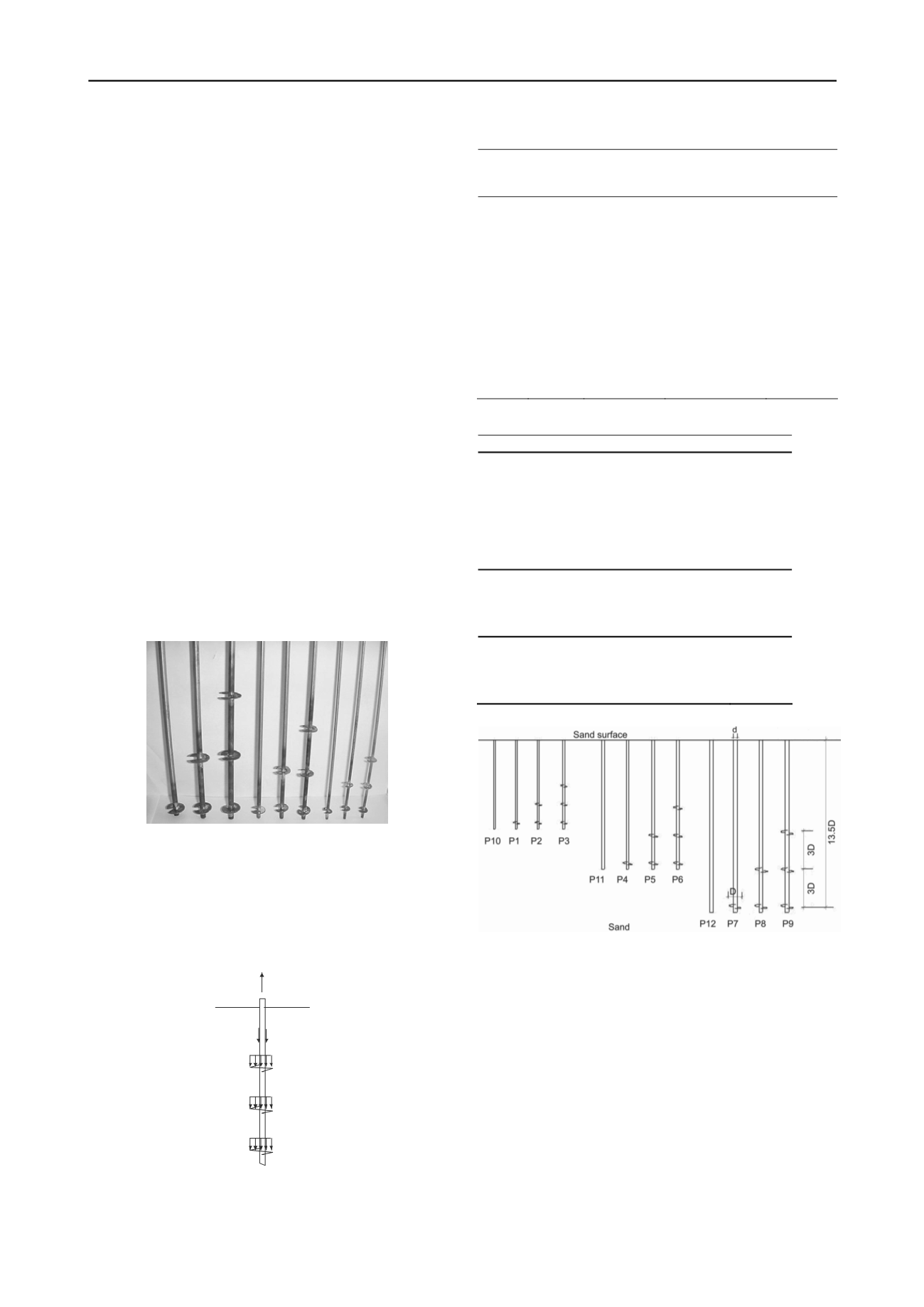
2894
Proceedings of the 18
th
International Conference on Soil Mechanics and Geotechnical Engineering, Paris 2013
different experimental programs were performed to this aim.
Initially, centrifuge model experiments were carried out on
scaled models of helical anchors with different dimensions in
sand, at the “French Institute of Science and Technology for
Transport, Development and Networks” (IFSTTAR) in Nantes,
France, to investigate the variability of the rate of capacity gain
due to the addition of one more helix to a helical anchor.
Considering that the use of helical anchors as tower
foundation has being increased in Brazil, and tropical soils
covers a significant part of the Brazilian territory, the second
experimental program of the present investigation was carried
out at a site of tropical soil, to evaluate the influence of the
helical anchor configuration on the installation torque and on its
uplift capacity.
2 EXPERIMENTS
2.1 Centrifuge testing modeling
A centrifuge model program was performed at the IFSTTAR, in
France, to verify the influence of the diameter and number of
helices on the multi-helix anchor uplift capacity in sand. The
purpose of centrifuge modeling is to reproduce a full-scale
response, with the possibility of comparisons between helical
anchors with different dimensions, as the model anchors were
installed in a uniform sand mass.
Nine small-scale anchor models (Figure 2; Table 1) were
tested in two different samples of dry NE34 Fontainebleau silica
sand (Table 2), with relative densities of 56% (container 1) and
85% (comtainer 2), respectively. The samples were prepared by
the air-pluviation technique in two containers with dimensions
of 1200 mm × 800 mm in plan area and a height of 340 mm.
Figure 2. Photography of the model anchors.
For this investigation, tension load tests were performed on
reduced-scale model piles, without helical plates (P10 to P12),
to separate the shaft resistance, Q
s
, from the total helical anchor
uplift capacity, Q
u
(see Figure 3 and 4). The cylindrical model
anchors (multi-helix with same plate diameter), shown in Figure
2, were fabricated with the spacing between any two helices of
three times the helix diameter.
Q
u
Q
s
Q
h3
Q
h2
Q
h1
sand
Figure 3. Resisting forces to upward movement of a multi-helix anchor
in sand according to the “ individual bearing” failure mechanism.
Table 1. Dimensions of model anchors (M) and prototype anchors (P).
Pile
Nº
of helix
Shaft
diameter
d
M
(d
P
) mm)
Helix
diameter
D
M
(D
P
) (mm)
Prototype
tip depth
(m)
P1
1
3.0(64.3)
10(214)
3.1
P2
2
3.0(64.3)
10(214)
3.1
P3
3
3.0(64.3)
10(214)
3.1
P4
1
4.5(97.7)
15(326)
4.6
P5
2
4.5(97.7)
15(326)
4.6
P6
3
4.5(97.7)
15(326)
4.6
P7
1
6.0(132)
20(440)
6.2
P8
2
6.0(132)
20(440)
6.2
P9
3
6.0(132)
20(440)
6.2
P10
-
3.0(64.3)
10(214)
3.1
P11
-
4.5(97.7)
15(326)
4.6
P12
-
6.0(132)
20(440)
6.2
Table 2. Sand properties.
Property
Value
Unit weight of soil particles (kN/m
3
)
25.90
Maximum dry density (kN/m
3
)
16.68
Minimum dry density (kN/m
3
)
14.13
Maximum void radio
0.834
Minimum void radio
0.550
Maximum porosity
0.455
Minimum porosity
0.355
Container 1
Unit weight (kN/m
3
)
15.46
Density index (%)
56
Friction angle (º )
31
Container 2
Unit weight (kN/m
3
)
16.30
Density index (%)
85
Friction angle (º )
41
Figure 4. Model piles installed in the sand sample.
A total of 18 tensile loading tests were carried out on the
model anchors, nine in the sand container 1, and nine in the
container 2. The model anchors were installed at three different
depths as illustrated in Figure 4. Further details of this
experimental investigation are described in Tsuha et al. (2007).
2.1.1 Results of centrifuge tests
Figure 3 shows examples of load–displacement curves of tensile
tests performed on the model anchors of 214mm helix
(prototype) diameter, installed in the container 2 (denser sand).
The curves of the other loading tests carried out for this
investigation are presented in Tsuha et al. (2012).
From the results of this investigation, the fractions of the
total helix bearing capacity (Q
h
), related to each helical plate of
the double-helix anchors (F
Qhi
= Q
hi
/Q
h
, where Q
hi
is the uplift
helix bearing capacity of helix i), were calculated. The portion
of helix bearing capacity related to the second helix (Qh
2
) of the
double-helix anchors was determined by the difference between


